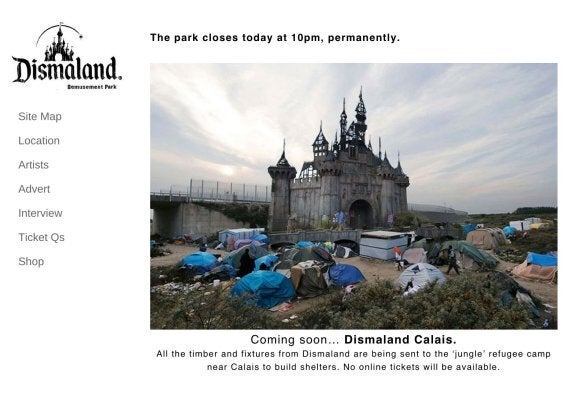The most depressing theme park in Britain will be dismantled and sent to Calais to build shelters for refugees, Banksy has announced.
Today is the last day visitors can see Banksy's bemusement park, which has attracted thousands of people since it opened its doors to the public on August 22.
On Monday, Dismaland will be taken down and all the timber and fixtures will be sent across the Channel, where there are currently about 5,000 people camped out.

Notice on the Dismaland website
A notice on the Dismaland website read: "Coming soon… Dismaland Calais.
"All the timber and fixtures from Dismaland are being sent to the ‘jungle’ refugee camp near Calais to build shelters. No online tickets will be available."
Above the message was a picture of Dismaland's iconic, burnt and broken Cinderella castle surrounded by tents.
The seaside attraction has been sold out everyday for five weeks, with about 4,000 people entering it each day.
It is estimated that Banksy's latest work has brought in about £20 million to Weston-super-Mare.
In true Banksy form, the mysterious street artist's latest creation touched upon a number of controversial topics, including the migration crisis, Jimmy Savile and the death of Princess Diana.
Article continues below slideshow:
When Dismaland opened, Banksy described the park as "a festival of art, amusements and entry-level anarchism", adding: "This is an art show for the 99% who'd rather be at Alton Towers."
The Bristol-based artist later told The Sunday Times: "This is not a street art show. It's modelled on those failed Christmas parks that pop up every December – where they stick some antlers on an Alsatian dog and spray fake snow on a skip.
"It's ambitious, but it's also crap. I think there's something very poetic and British about all that."
The park includes a wide range of work from artists from around the world, including talent from Israel, Palestine, Syria, the US and the UK.
Banksy credits 10 pieces of artwork to himself - the most iconic being Cinderella's castle, which will be used to provide shelter to refugees in Calais.
There are currently thousands of refugees in Calais, living in makeshift tents, many of whom are fleeing war-torn countries such as Syria.